
The Coopworth breed of sheep was developed by a team of scientists at Lincoln College in Canterbury, New Zealand, to increase lambing percentages of Romney ewes when mated with Border Leicester rams. The breed makes up the second largest flock in New Zealand. It is also bred in Australia, parts of Europe, and the United States. The Coopworth is used for both meat and wool. An average fleece weighs 5 kg, with a fibre diameter of about 30 to 35 microns being in the coarser range of wools with a staple length of between 125 and 200 mm. The live weight of an adult is about 55 kg.
The Perendale is a breed of sheep developed in New Zealand by Massey Agricultural College for use in steep hill situations. The breed is named after Sir Geoffrey Peren, and it achieves its aims by being the offspring of Romney ewes and Cheviot rams with sturdy legs. It is raised primarily for meat.

The Lincoln, sometimes called the Lincoln Longwool, is a breed of sheep from England. The Lincoln is the largest British sheep, developed specifically to produce the heaviest, longest and most lustrous fleece of any breed in the world. Great numbers were exported to many countries to improve the size and wool quality of their native breeds. The versatile fleece is in great demand for spinning, weaving and many other crafts.

The Manx Loaghtan ( loch-tan) is a rare breed of sheep native to the Isle of Man. It is sometimes spelled as Loaghtyn or Loghtan. The sheep have dark brown wool and usually four or occasionally six horns.
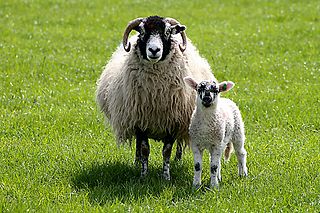
Swaledale is a breed of domestic sheep named after the Yorkshire valley of Swaledale in England. They are found throughout the more mountainous areas of Great Britain, but particularly in the Yorkshire Dales, County Durham, and around the pennine fells of Cumbria.

Not to be confused with the Olde English 'Babydoll' Southdown sheep.

The Romney, formerly called the Romney Marsh sheep but generally referred to by the local farmers as the Kent, is a breed of sheep originating in England. The Romney is a "long-wool" breed recognized in England by 1800. Exported to other continents, the Romney is an economically important sheep breed, especially to the sheep-meat and wool export trades of New Zealand.
The Polypay sheep breed is a white, medium-sized, polled sheep which was developed in the 1960s at the U.S. Sheep Experiment Station in Dubois, Idaho. In general, Polypay sheep are noted for being a highly prolific maternal dual-purpose breed. It produces yearly about 4.2 kg of wool and is weaned at 120 days.

The Shetland is a small, wool-producing breed of sheep originating in the Shetland Isles, Scotland but is now also kept in many other parts of the world. It is part of the Northern European short-tailed sheep group, and it is closely related to the extinct Scottish Dunface. Shetlands are classified as a landrace or "unimproved" breed. This breed is kept for its very fine wool, for meat, and for conservation grazing.

The Columbia is one of the first breeds of sheep developed in the United States. The product of USDA and university research, it was intended to be an improved breed adapted for the Western ranges of the country.
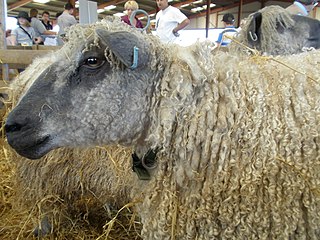
The Wensleydale is a British breed of domestic sheep. It is named for the Wensleydale region of North Yorkshire, in the north of England, where it was bred in the early nineteenth century by cross-breeding a Dishley Leicester ram with local long-woolled sheep of a breed that is now extinct. It has a blue-grey face and long purled wool, and is among the heaviest of British sheep breeds. It is an endangered breed, and is categorised as "at risk" by the Rare Breeds Survival Trust. It is often used as a ram breed to cross with other breeds to obtain market lambs, and for its high-quality wool.

Sheep are quadrupedal, ruminant mammals typically kept as livestock. Like most ruminants, sheep are members of the order Artiodactyla, the even-toed ungulates. Although the name sheep applies to many species in the genus Ovis, in everyday usage it almost always refers to Ovis aries. Numbering a little over one billion, domestic sheep are also the most numerous species of sheep. An adult female is referred to as a ewe, an intact male as a ram, occasionally a tup, a castrated male as a wether, and a young sheep as a lamb.
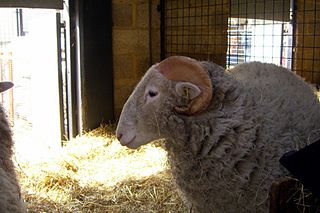
The Whitefaced Woodland is a sheep breed from the Woodlands of Hope an area in the South Pennines in England. It is a combination of two breeds, the Woodland and the Penistone sheep after the Yorkshire town where sheep sales have been held since 1699. It is thought to be closely related to the Swaledale and the Lonk. Substantial commercial flocks of the Whitefaced Woodland are kept in its region of origin, but it is listed as a vulnerable breed by the Rare Breeds Survival Trust, since there are fewer than 900 registered breeding females in Great Britain.

The Racka or Hortobágy Racka Sheep(Ovis aries strepsiceros hungaricus) is a breed of sheep known for its unusual spiral-shaped horns. These unique appendages are unlike any other domestic sheep horns, and may grow up to 2.0 ft (0.61 m) long. The smallest standard length is 20 in (51 cm) for rams and 12–15 in (30–38 cm) for ewes.
The British Milksheep is a robust, dual-purpose sheep commonly known for its milking characteristics.

Gromark sheep are a large-framed, plain bodied dual-purpose breed of sheep that were under development in 1965 by Arthur C. Godlee at "Marengo", Tamworth, New South Wales. They were selected for a high growth rate, fertility, wool quality and carcase attributes.
The Eliottdale is a breed of domestic sheep originating from Tasmania. It is a carpet wool breed raised primarily for its wool. Due to the amount of wool grown by the Eliottdale, it needs to be shorn twice per year.
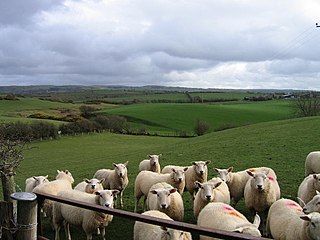
Sheep farming has been important to the economy of Wales. Much of Wales is rural countryside and sheep are seen throughout the country. The woollen industry in Wales was a major contributor to the national economy, accounting for two-thirds of the nation's exports in 1660. Sheep farms are most often situated in the country's mountains and moorlands, where sheepdogs are employed to round up flocks. Sheep are also reared, however, along the south and west coasts of Wales. In 2017 there were more than 10 million sheep in Wales and the total flock made up nearly 33% of the British total. In 2011 sheep farming accounted for 20% of agriculture in Wales.
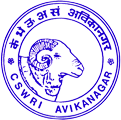
The ICAR-Central Sheep and Wool Research Institute (ICAR-CSWRI) is an Indian Council of Agricultural Research subsidiary commissioned for research, training and extension activities related to sheep and rabbits. The Institute is an autonomous body and is sponsored by the Department of Agricultural Research and Education (DARE), Ministry of Agriculture, Government of India. It is situated in Avikanagar, Malpura, in Rajasthan, India. It works in close liaison with the other ICAR institutes, Central Wool Development Board, Sheep and Wool Marketing Federation, Department of Biotechnology (GOI), Small Entrepreneurs, NGOs, State Animal Husbandry and Khadi gram and Cottage industries.
Animal husbandry in Azerbaijan is concerned with animals that are raised for meat, milk, eggs, leather, wool, fur and fibre production for people’s consumption in Azerbaijan.















